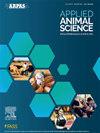Effects of byproduct-based diets or grain-based diets on performance and carcass quality of beef steers finished on pasture
IF 1.5
Q3 AGRICULTURE, DAIRY & ANIMAL SCIENCE
引用次数: 0
Abstract
Objective
A study was conducted to evaluate effects of 2 pasture-based finishing systems, compared with a conventional finishing method, on live performance and carcass quality of steers.
Materials and Methods
Sixty-three crossbred beef steers (363.9 ± 28.7 kg) were blocked by BW and randomly assigned to one of either 7 pens or 14 pasture paddocks. Treatments consisted of conventional finishing diet (FDLT), or 2 pasture-based diets fed at 2% to 2.25% of BW of either grain-based (STCH) or byproduct-based diets (BYPD). In addition to their diet, steers on the pasture-based treatments were able to graze warm-season perennial forages. Steers were fed their respective diets once daily for 161 d and were harvested at a commercial slaughter facility in Arkansas City, Kansas. Performance and carcass data were analyzed using PROC GLIMMIX and PROC MIXED (SAS 9.4); pen and pasture were the experimental units, treatment was a fixed effect, and block was considered a random effect.
Results and Discussion
Cattle fed FDLT and BYPD had greater BW on d 112 and 140 (P ≤ 0.02), and greater overall carcass-adjusted BW (P = 0.03) compared with STCH. Due to the limit-fed nature of the treatments, both STCH and BYPD had more efficient nonpasture-only feed conversion through d 56, between d 85 and 140, and between d 0 and 161 (P ≤ 0.05). Hot carcass weight tended (P = 0.13) to be greater for BYPD and FDLT compared with STCH. Marbling score tended (P = 0.14) to be greater for BYPD compared with FDLT and STCH. No differences (P ≥ 0.34) were noted in other carcass characteristics.
Implications and Applications
Data from this study suggest that feeding byproduct feed mixtures to beef cattle grazing pasture could successfully be used as an alternative finishing method without affecting carcass quality.
副产品饲粮和谷物饲粮对牧场肉牛生产性能和胴体品质的影响
目的研究两种放牧育肥体系对阉牛活产性能和胴体品质的影响,并与传统育肥方式进行比较。材料与方法选用体重为363.9±28.7 kg的杂交阉牛63头,随机分为7个栏和14个牧场。处理包括传统的育肥期饲粮(FDLT),或2种以2% ~ 2.25%体重的谷物型饲粮(STCH)或副产品型饲粮(BYPD)为基础的牧场饲粮。除了他们的饮食,放牧处理的牛能够吃暖季多年生牧草。在161天内,每天饲喂一次各自的饲粮,并在堪萨斯州阿肯色市的一家商业屠宰场收获。使用PROC GLIMMIX和PROC mix (SAS 9.4)分析生产性能和胴体数据;围栏和牧场是实验单位,处理是固定效果,而阻塞被认为是随机效果。结果与讨论与STCH相比,饲喂FDLT和BYPD的牛在第112天和第140天的体重更高(P≤0.02),总体胴体调整体重更高(P = 0.03)。在第56 d、第85 ~ 140 d和第0 ~ 161 d, STCH和BYPD均具有更高的非放牧饲料转化率(P≤0.05)。与STCH相比,BYPD和FDLT的热胴体重更大(P = 0.13)。与FDLT和STCH相比,BYPD的大理石纹评分倾向于更高(P = 0.14)。其他胴体性状差异无统计学意义(P≥0.34)。启示和应用本研究的数据表明,在不影响胴体质量的情况下,向放牧的肉牛饲喂副产物混合饲料可以成功地作为一种替代的肥育方法。
本文章由计算机程序翻译,如有差异,请以英文原文为准。
求助全文
约1分钟内获得全文
求助全文

 求助内容:
求助内容: 应助结果提醒方式:
应助结果提醒方式:


